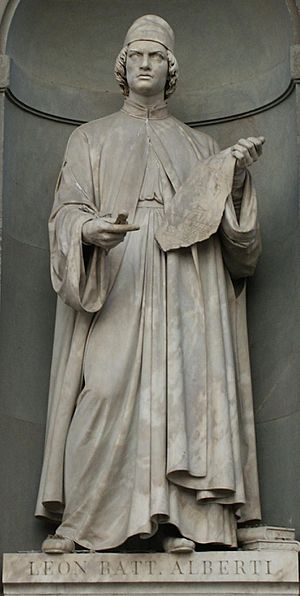Leone Battista Alberti facts for kids
Quick facts for kids
Leon Battista Alberti
|
|
|---|---|

Late statue of Leon Battista Alberti. Courtyard of the Uffizi Gallery, Florence
|
|
| Nationality | Italian |
| Known for | Architecture, Linguistics, Poetry |
|
Notable work
|
Tempio Malatestiano, Palazzo Rucellai, Santa Maria Novella |
| Movement | Italian Renaissance |
Leon Battista Alberti (born February 18, 1404 – died April 25, 1472) was a very talented Italian person from the Italian Renaissance period. He was known as a "universal man" because he was good at so many different things! He was an author, artist, architect, poet, and even a priest. He also studied languages, philosophy, and secret codes (cryptography).
Alberti was born in Genoa, Italy. His family, the Albertis, had been sent away from their home city of Florence. When he was a child, his family moved to Venice. He finally visited Florence for the first time in 1428. His life story was written down by Giorgio Vasari in a book called Vite.
Contents
A Renaissance Man
Leon Battista Alberti was a true Renaissance man. This means he had many skills and interests. He believed that people should try to learn and do as much as they could. He was not just an artist or an architect; he was also a deep thinker and a writer.
He wrote important books about art and architecture. These books helped shape how artists and builders thought during the Renaissance. He was one of the first to write about the rules of perspective in art. Perspective is a way to make flat pictures look like they have depth and distance.
Architectural Masterpieces
Alberti designed many famous buildings in Italy. His work showed the new ideas of the Renaissance. He often used classical Roman styles in his designs. This meant using columns, arches, and careful measurements.
Tempio Malatestiano
One of his most famous works is the Tempio Malatestiano in Rimini. This building was originally a church. Alberti was asked to redesign its outside. He made it look like an ancient Roman temple.
Palazzo Rucellai
In Florence, Alberti designed the Palazzo Rucellai. This palace is a great example of Renaissance architecture. It has three levels, each with different types of columns. It looks very grand and balanced.
Santa Maria Novella
Alberti also worked on the facade (front) of the Santa Maria Novella church in Florence. He added new parts to the church's front. He used scrolls and classical elements to connect the different sections. This made the church's front look more harmonious and complete.
Other Talents
Besides architecture, Alberti was also a talented writer. He wrote plays, poems, and essays. He even wrote about how to build ships and how to measure things. He was interested in many different fields of knowledge.
He also studied linguistics, which is the study of language. He was a philosopher, thinking deeply about life and knowledge. He even worked on cryptography, which is the art of writing and solving secret codes. His wide range of skills made him one of the most important figures of his time.
Images for kids
-
A portrait of Alberti by Filippino Lippi is thought to exist in the Brancacci Chapel, as part of Lippi's completion of the Masaccio painting, the Raising of the Son of Theophilus and St. Peter Enthroned
See also
 In Spanish: Leon Battista Alberti para niños
In Spanish: Leon Battista Alberti para niños








